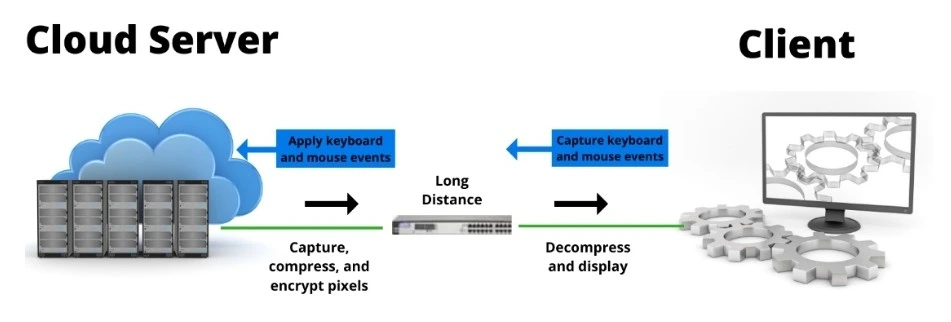Cloud Enablement for CAD Applications
- Home
- Blog Details

- August 26 2022
- admin
Over the last decade, multiple manufacturing-related applications have moved to the cloud to reduce hardware investments and to avail of the benefits of IT resource aggregation. CAD, which plays a crucial role in product development, is often considered a potential candidate for cloud enablement.
As CAD software consumes dedicated high-end compute and graphics resources, a definite business case exists to move CAD on cloud. Moving CAD on cloud can bring multiple benefits like increased flexibility, better collaboration, and ultimately reduced cost of hardware and maintenance. AutoCad Cloud is one such example of cloud-based CAD platform which enables creating, editing, viewing, and sharing drawings without having to install it on your system.
Almost all CAD ISVs are considering some form of cloud enablement, but it has not picked the pace for multiple reasons. The following sections discuss these issues and possibly how they will evolve.

Current State of Cloud-based CAD
Cloud has popularized the on-demand access to resources and usage-based charges. It has helped the customers to transition the cash flow from an upfront fixed cost to a variable cost. Almost all types of software can now be licensed in this model. CAD software ISVs are following this trend by shifting from perpetual license + AMC to an annual subscription model with support. For the cloud, adoption evolution can be seen in all three types of cloud adoption – IaaS, PaaS, and SaaS.
- IaaS (Infrastructure as a Service) – The infrastructure (e.g., compute and storage) is provisioned from the cloud in the form of dedicated Virtual Machines (VMs). VM can be started when required and stopped in off hours. This model is easy to adopt, with no change in CAD application. This model can also be implemented in-house (i.e., private cloud), giving more control over the security aspects.
- PaaS (Platform as a Service) – The platform provider hosts a set of services that enables the creation of purpose-built applications and automates or scales specific workflows from inside the CAD application. The platform provider manages the services in terms of availability and security and can be accessed via APIs, typically in pay-per-use mode. Accessing PaaS requires some knowledge of programming.
- SaaS (Software as a Service) – The software provider also hosts the application, and manages security, performance, etc. Users do not require any CAD installation/configuration and can access it via a browser running on any device. The created CAD data is also stored and managed by the SaaS provider, with more collaboration opportunities. To access the SaaS-based CAD, users typically pay a subscription fee.
There are visible progressions in each type, and a few ready solutions are already available in the market. However, there remain technology hurdles and user adoption issues.
Technological Issues with CAD on the Cloud
Moving CAD on cloud requires some critical pieces to be recreated to suit the cloud architecture. It would take a significant effort to redevelop these pieces and bring them to par with current levels.
- CAD applications are unique, requiring some complex mathematical algorithms developed in the 80s and 90s using procedural programming languages. Modern CAD applications consist of multiple layers built on top of these, sometimes in different languages. Moving all this to modern programming languages and frameworks that utilize computational resources more efficiently is not easy.
- CAD applications are highly interactive, where the user sees the 3D model, pan/zoom / rotates the model to visualize the complete model, and picks appropriate entities as input. It requires very heavy and fast graphics rendering, which may not be available on all user devices. Moving the rendering to a server requires continuous communication and data exchange with the server, which gets affected by bandwidth/latency.
- CAD Applications are predominantly file-based, where each user operation and its outcome gets appended to a file. For cloud-based CAD applications, the operations done on a particular file are restricted to a specific server. It makes it inefficient to scale the infrastructure in tune with the user load. It is possible to work around this issue, but it poses other performance challenges.
CAD ISVs strive to address the above and many other technical issues, with few breakthroughs. However, user adoption is still low due to various process-related issues.
Adoption Issues
CAD Applications have been used by various product development OEMs and their suppliers for over a quarter century. These organizations have evolved custom workflows and security processes around CAD. Moving to cloud-based CAD will need multiple adjustments to these processes, which could be a significant hurdle in adoption.
- PDM/PLM system – The CAD needs to work with the PDM/PLM system to manage the product’s lifecycle. Hence it is necessary to put PDM/PLM on the cloud before putting the CAD on cloud. The PDM/PLM systems run complex workflows often customized/configured per the organization’s processes. Moving these on a cloud-based system is quite a complex exercise due to the huge data accumulated over the years.
- Security Concerns – CAD is an IP authoring tool on which organizations create their core IP and refine it over the years. The CAD data is subjected to stringent IT and physical security for IP protection and regulatory requirements. It makes the organizations very cautious about putting the data in the cloud, especially if they do not have direct control, adding another challenge to cloud adoption.
- Ecosystem Dependency – CAD data often get exchanged between the supplier and OEM for the product integration/packaging. To ensure data consistency and avoid conversion errors, this ecosystem prefers to use the same CAD system and even the same version. It requires supplier and OEM to move to the cloud-enabled version at once, which is not always possible.
In addition to the above points, there are factors like usability due to latency issues and significant concerns of the customers in the form of vendor lock-in. These have been discussed at many forums, hence not elaborated here.
Way forward
As cloud technology advances, some challenges could get addressed or become irrelevant. However, looking at the overall picture, cloud adoption is likely to evolve on two fronts –
- Small/Medium enterprises with casual usage will preferably adopt PaaS or SaaS
- Large enterprises will be the last to move to IaaS with infrastructure managed by themselves
- adminhttps://www.pre-scient.com/author/webwideit/
- adminhttps://www.pre-scient.com/author/webwideit/
- adminhttps://www.pre-scient.com/author/webwideit/
- adminhttps://www.pre-scient.com/author/webwideit/

